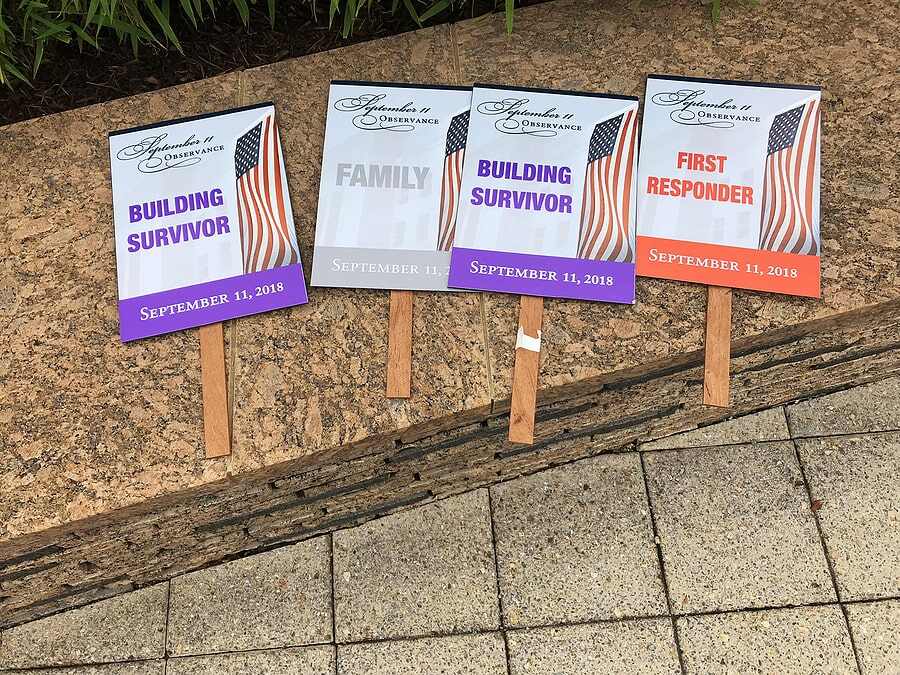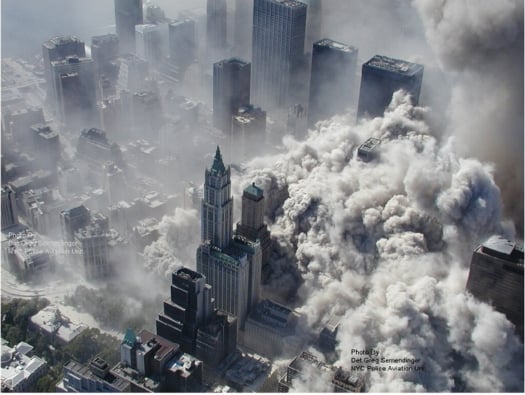Workers Who Survived 9/11 Near Ground Zero Now Battle For Their Lives

Workers Who Survived 9/11 Near Ground Zero Now Battle For Their Lives. On September 11, 2001, Chris was walking to his job on the floor of the New York Stock Exchange when he heard a plane flying too close to the Manhattan skyline. The next thing he knew, he saw smoke barreling through the street. He found himself in a suit and tie, covered in soot, jumping along with 10 of his coworkers into a boat that his wife navigated from their home in Brooklyn to the South Street Seaport.
A week later? He was back to work.
Nearly two decades later, Chris began experiencing excruciating burning and pain. Within a month of when he first began experiencing symptoms, he was diagnosed with 9/11-related bladder cancer. He obtained membership in the WTC Health Program, which provides medical care and monitoring of 9/11-related conditions. Additionally, he filed a September 11th Victim Compensation Fund (VCF) claim and obtained compensation, though he said, “I would give it all back in a heartbeat if I didn’t have to go through what I went through.”
About 360,000 individuals were working in the area or passing through near Ground Zero when the 9/11 terror attacks on the World Trade Center occurred. Sorrentino wants others who were in the area to understand that the federal benefits programs are for more than just rescue and recovery workers. Medical care, monitoring, and compensation are also available for survivors of the attack, including those who worked in the area.
If you were exposed to the toxic dust plume at Ground Zero on 9/11 or in the months that followed while you worked, lived, or attended school in the area and you were diagnosed with or are experiencing symptoms of a serious illness related to that exposure, an attorney with experience in 9/11 cases can obtain the benefits you deserve
Who Was Working on 9/11?
The Twin Towers were the centerpiece in a sprawling World Trade Center complex that provided nearly 10 million square feet of office space to accommodate around 35,000 people working for 430 different companies. The towers were the tallest buildings in the city and around 70,000 tourists and commuters visited them each day. In addition to people who worked in the office buildings and escaped before the towers collapsed, the terrorist attacks exposed hundreds of thousands of workers and visitors in other buildings in the densely packed 1.5-mile radius in the New York City disaster area to toxins from the dust plume.
About 17,000 workers and visitors were inside the World Trade Center towers when the attacks occurred. Fewer than 10 percent of the occupants of the towers evacuated when the alarms sounded. The majority waited for further instructions and completed other tasks such as gathering their belongings or calling family members.
Building 3 at the World Trade Center, known as the Marriott World Trade Center Hotel, became the evacuation runway for people fleeing the towers. Around 940 registered guests stayed at the hotel when the attacks took place, most of whom evacuated after a piece of one of the planes’ landing gear landed on the building’s top floor pool, setting off the alarms.
Evacuation orders went to residents and workers in all of the surrounding buildings in Lower Manhattan, with boats and ferries used to further remove survivors from the area as it became increasingly congested after the attacks. The companies that lost the most workers in the terrorist attacks were those located above the impact point in the towers, including Cantor Fitzgerald, which lost 658 employees; Marsh & McLennan, with 295 casualties, and Aon Corporation, with 175.
According to survey answers provided by the WTC Health Registry survivor group, 83 percent of the occupants in offices located within the NYC disaster area were evacuated on 9/11, as well as 61 percent of the residents who lived in the area. However, many of these individuals returned to work, school, or home within days of the disaster.
What 9/11-Related Conditions Have Survivors Suffered From?
Nearly 30,000 9/11 survivors receive medical care and monitoring of certified conditions through the WTC Health Program, accounting for 27 percent of the program’s membership rolls. More than 800 survivor WTC Health Program members have died since the program began in 2011. The largest survivor group is currently between the ages of 55 and 64, meaning many were in their 30s and 40s—prime working years—at the time of the attack.
Here is a look at the conditions they are suffering from:
- Chronic rhinosinusitis (nasal inflammation): More than 6,000 survivors diagnosed.
- Gastroesophageal reflux disease (GERD): More than 5,000 survivors diagnosed.
- Cancers: More than 9,000 survivors diagnosed. The most common cancers impacting WTC survivors include non-melanoma skin cancer, prostate cancer, female breast cancer, melanoma of the skin, lymphoma, and thyroid cancer.
- Asthma: Nearly 5,000 survivors diagnosed.
- Sleep apnea: More than 1,400 survivors diagnosed.
- PTSD: Nearly 3,700 survivors diagnosed.
- Chronic respiratory disorder: More than 1,200 diagnosed.
Why Did so Many People Return to the Area so Quickly?
Unfortunately, many survivors experienced more exposure to the toxic dust as they quickly returned to home, work, and school. Part of the confusion about the danger of the World Trade Center dust resulted from an official from the Environmental Protection Agency announcing almost immediately that toxicity levels were safe.
Government officials, undoubtedly eager to turn the wheels of the area’s economy again, repeated these narratives. This resulted in not only an increased risk for survivors of the immediate area who were caught in the dust plume but also of individuals who were only exposed to the toxins when returning to dust-covered homes and office buildings early.
Reaching out to Survivors
Around the September 11th attacks, Yvonne was working at a community college in Downtown Manhattan. She experienced headaches and breathing problems for months after the attacks as she continued to work in the toxic dust that lingered in the area until mid-2002. Sixteen years later, she was surprised to learn that she had breast cancer. She spent months fighting the condition before learning that the WTC Health Program would have provided her medical care for free. Her awareness of the program came through a friend who had heard an ad about the WTC Health Program on the radio about a year after her diagnosis.
Indications are that Yvonne is certainly not the only survivor that was not aware that they could obtain free medical care for life through the program. Despite estimations that hundreds of thousands of survivors were in the area and exposed to the toxins, only a small fraction has sought to become members of the WTC Health Program.
Some reasons for this lack of knowledge about the program include:
- The failure of the federal government to directly communicate with affected individuals about the program.
- The belief that one’s medical or mental health condition is not “serious” enough to qualify them for benefits.
- Limited knowledge of the program, but the mistaken belief that only responders qualify.
Which Survivors Qualify for Federal 9/11 Benefits?
According to the WTC Health Program, survivors are eligible to obtain benefits if they:
- Were present in the toxic dust plume at Ground Zero on September 11, 2001.
- Worked, lived, or attended daycare in the NYC disaster area for at least four hours on four separate days between September 11, 2001, and July 31, 2002.
- Worked as a cleanup or maintenance worker in the NYC disaster area for at least four hours on four separate days between September 11, 2001, and July 31, 2002, but did not meet the general responder criteria.
- Those who qualified for Lower Manhattan Development Corporation grants and resided or worked in the NYC disaster area between September 11, 2001, and May 31, 2003.
About the Federal 9/11 Benefit Programs
In 2011, then-President Barack Obama signed the James Zadroga 9/11 Health and Compensation Act into law.
This act created the WTC Health Program, which replaced several other benefit programs providing similar services. The program offers free medical care and monitoring for 9/11 responders meeting the time of exposure and presence criteria, provided they receive their medical treatment and prescriptions at a program-affiliated facility or through a networked health care provider.
The WTC Health Program also provides certification of 9/11-related medical and mental health conditions. These certifications meet the eligibility criteria for a VCF claim.
The Zadroga Act also reauthorized the September 11th Victim Compensation Fund (VCF), which was closed since 2004. The VCF provides compensation for wage loss and pain and suffering to responders and survivors who have suffered from at least one 9/11-related condition that has been certified by the WTC Health Program. The VCF also provides wrongful death compensation to family members of survivors who have died from a 9/11-related medical condition. Individuals can seek additional compensation when they have been diagnosed with additional conditions.
Congress reauthorized two programs to continue providing services for 9/11 survivors and responders until October 2090. While you can apply with the WTC Health Program and register with the VCF any time between now and 2090, survivors should sign up for these programs as soon as possible to obtain a free initial health screening and to reserve their right to file a VCF claim.
Questions About Benefits for 9/11 Survivors? Contact a 9/11 Attorney Today



